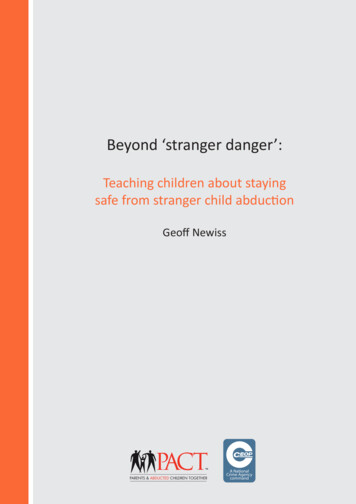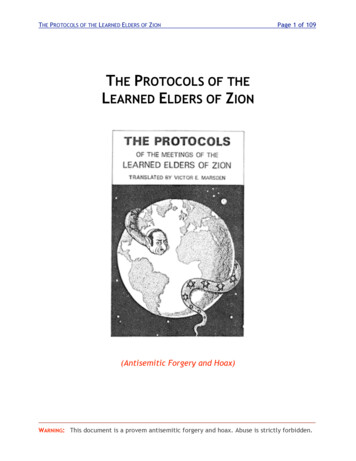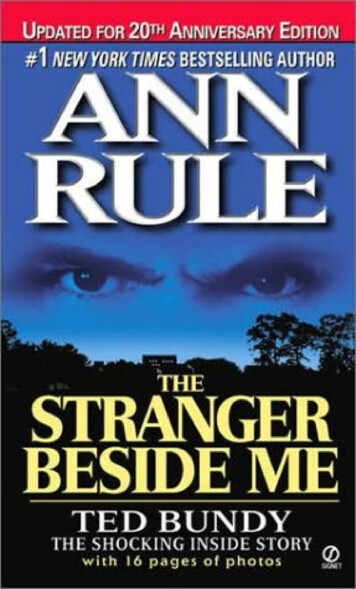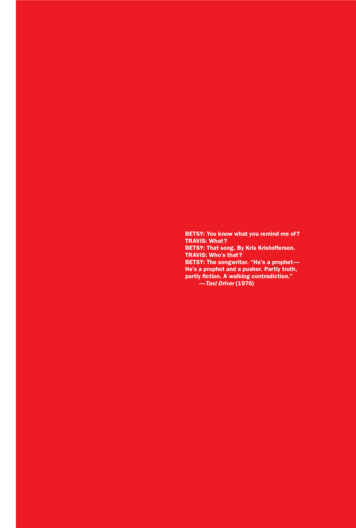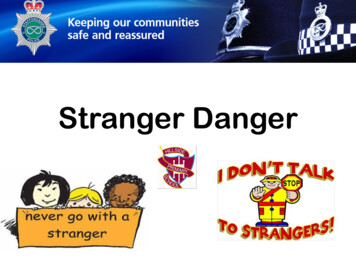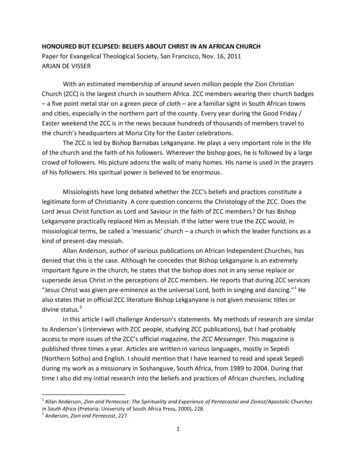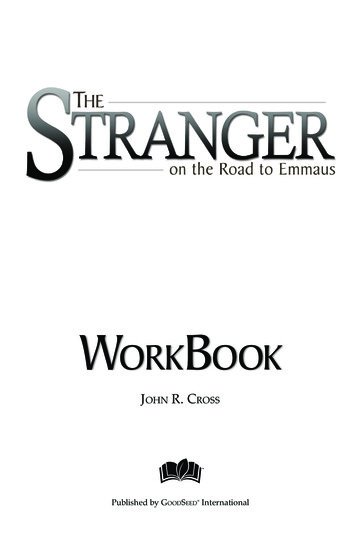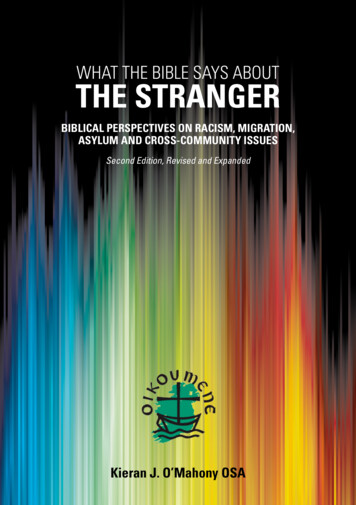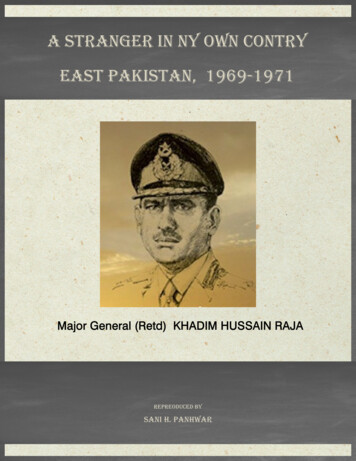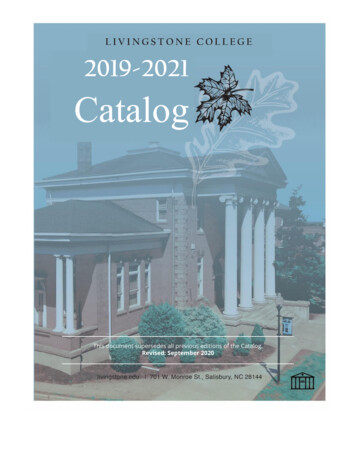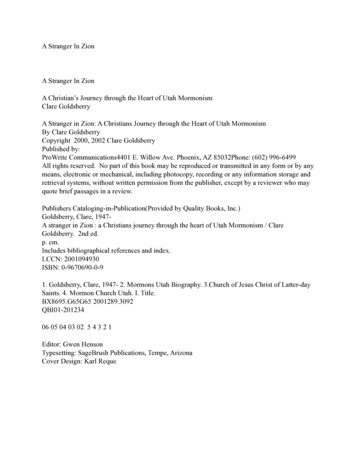
Transcription
A Stranger In ZionA Stranger In ZionA Christian’s Journey through the Heart of Utah MormonismClare GoldsberryA Stranger in Zion: A Christians Journey through the Heart of Utah MormonismBy Clare GoldsberryCopyright 2000, 2002 Clare GoldsberryPublished by:ProWrite Communications4401 E. Willow Ave. Phoenix, AZ 85032Phone: (602) 996-6499All rights reserved. No part of this book may be reproduced or transmitted in any form or by anymeans, electronic or mechanical, including photocopy, recording or any information storage andretrieval systems, without written permission from the publisher, except by a reviewer who mayquote brief passages in a review.Publishers Cataloging-in-Publication(Provided by Quality Books, Inc.)Goldsberry, Clare, 1947A stranger in Zion : a Christians journey through the heart of Utah Mormonism / ClareGoldsberry. 2nd ed.p. cm.Includes bibliographical references and index.LCCN: 2001094930ISBN: 0-9670690-0-91. Goldsberry, Clare, 1947- 2. Mormons Utah Biography. 3.Church of Jesus Christ of Latter-daySaints. 4. Mormon Church Utah. I. Title.BX8695.G65G65 2001289.3092QBI01-20123406 05 04 03 02 5 4 3 2 1Editor: Gwen HensonTypesetting: SageBrush Publications, Tempe, ArizonaCover Design: Karl Reque
DedicationTo my four wonderful children, Keith, Lori, Matthew, and Bryan, whose patience with me as Istruggled to find my spiritual path gave me strength and taught me to be patient with them asthey seek their own spiritual paths.This book is a true story based on events of my life during the time I lived in Kaysville, Utah,and shortly after moving to Arizona. However, to protect the privacy of friends andacquaintances, I have changed their names and other identifying references. Only historicalfigures and family members (Dee Goldsberry and my children, Keith, Lori, Matthew and Bryan)are still identifiable, along with names of General Authorities of the Church of Jesus Christ ofLatter-day Saints and other on-the-record sources quoted and used as a result of the research forthis book.Introduction: Into The FoldMormonism, as the religion of those who belong to the Church of Jesus Christ of Latterday Saints is called, is a purely American religion. Born on the frontier of western upstate NewYork out of the religious fervor known as the Second Great AwakeningFrom its beginning, Mormonism has always had its detractors and critics, both from the outsideand inside the church. As the church migrated from city to city in what then was then the newfrontier of Ohio, then Missouri and on to Illinois, it met with resistance. That resistance was notso much because of beliefs in angels coming to earth with golden plates, or that Joseph Smithsaw God and Jesus Christ, or even that it eventually took up the practice of having multiplewives known as polygamy. All of those things were accepted as commonplace in an era whennew religions were springing up along the frontier almost weekly in response to the guaranteesof religious freedoms upon which this new nation was founded. People tolerated and acceptedthe excesses and strange practices of many of these new religions almost unilaterally, given thatin the early 1800s people changed their religious affiliation nearly as often as they did theirunderwear.Religious revival meetings or camp meetings, as they were called, facilitated thesefrequent conversions from one religion to another. People met in large numbers, pitched theirtents, and spent days listening to the various preachers from a variety of denominations, eachtrying to convince listeners that his doctrine was the one to follow. In his book Religion inAmerica, Winthrope S. Hudson describes this period of time as one in which heightenedreligious interests would fan the spark of conversion into a wildfire that would take anothertwenty years to die down. In fact, that area of upstate New York where Joseph Smiths familyresided had experienced so many religious conversions from the various churches it becameknown as the burned-over district.Some historians say it was the Mormons attitude that often riled peoples’ passions againstthe group. That Mormons believed they were destined to establish Gods kingdom on earth thekingdom of the saints called Zion on this continent, and specifically in Jackson County, Missouri
The Mormons started out across the plains in 1847, led by a strong-willed successor to JosephSmith (who had been murdered while in jail in Carthage, Missouri), named Brigham Young. Thegroup did not really know where it was heading other than west. A few months later, Youngannounced from a point high above the Great Salt Lake Valley in Emigration Canyon that this isthe place. At Young’s direction, the group settled in a harsh environment where the only watervisible was unfit to drink because of its high salt content. However, the Mormons had faith inand followed their leader unquestioningly, as they had been taught to do. They overcameproblems such as the lack of fresh water by building canals to channel mountain streams. Whencrickets nearly destroyed the first year’s crops, they were saved thanks to multitudes of sea gullsthat came from nowhere and ate the crickets – one of many Mormon miracles. Youngcommissioned Porter Rockwell and his vigilante avenging angels to keep the Valley free of thosewho could ever again make life for the Mormons impossible. They handled threats from theoutside world in the form of other settlers, many of whom met their death at the hands of thevigilantes. Thus was established this country’s first theocracy. The Mormon people built theirkingdom of Zion, known to the secular world as Salt Lake City, and set about to make the desertblossom as a rose as ordained in their scripture, the Book of Mormon.Brigham Young originally intended to make the Utah territory an independent nation, atrue theocracy self-sufficient from the rest of the country. Plans called for the Utah territory toinclude Utah, most of Nevada, Arizona, and a strip into Southern California that would includepresent-day Santa Barbara to give the nation its own seaport. However, the federal governmentdid not look kindly on that plan, and so the people sought to make Utah a state instead.Although the church had to relinquish the law of polygamy in order to obtain statehood, theManifesto of 1893 was a change in doctrine not welcomed by some Mormons, particularly thosewith several wives and many children. Rather than deny polygamy and put out their wives andchildren to exist without means of support, these men moved with their large families toterritories in Arizona, Northern Mexico, and even Canada, where polygamy is still practicedtoday in many of those communities established at the turn of the century to accommodate thebeliefs of the Mormon fundamentalists as they came to be called.Today, Utah continues to be the closest thing to a theocracy that exists among the fiftyUnited States of America. Only in recent years have non-Mormons, who are becoming morepopulous in the state, gained a toehold in government. In a place where there are more Mormonsthan anything else, particularly in rural areas, and because Mormons typically vote for Mormons,those elected to government offices have been primarily Mormon. Many of the states lawscontinue to reflect Mormon doctrine, however in recent years many of the laws have changed togive the state a more secular appearance and opening it up even further to the world. With theWinter Olympics slated for 2002, the world will pour into Utah and into the Salt Lake Valley.Certainly the influences that Brigham Young sought to escape 150 years ago will confront UtahMormonism in new and challenging ways.The church (When you say ‘The Church’ in Utah, it is assumed that it is the MormonChurch since that is the only one recognized officially.) continues to have a major influence ondecisions to change the laws to be more accommodating to events such as the Winter Olympics,placing its blessings on those changes in order to win the popular support of the people. In Utah,perhaps more than in any other state, the Mormon people follow the voice of their churchleaders. The leaders have powerful influence over the vote of the people, despite the claim that
the church does not dictate how its members should vote or that it uses its pulpits to support aparticular candidate.In spite of attempts by the church to keep itself a separate and unique religion, in recentyears it has shown a desire to be accepted as a Christian religion. To improve its public image,Mormonism has attempted to remove the stigma of cult with which its critics have painted it formore than a century. That is where many of its problems lie. Mormons and non-Mormons alikechallenge certain doctrines of Mormonism, and the church has proved that doctrinal changecomes slowly, if at all.One example of change that drew mixed reaction from people both inside and outside thefold came when the church was forced to acknowledge and accept people of color. Suddenlyliterally overnight the church changed its long-standing doctrine banning African-American menfrom ever holding its priesthood offices. Then came changes in the text of the Book of Mormon,which previously said that Native Americans – if they became Mormon and followed Mormonways long enough would become a white and delightsome people, proof of Gods acceptance ofthem. Now, says the new Book of Mormon text, they will become a pure and delightsomepeople. Pressure from women, starting in the 1970s with the furor over the Equal RightsAmendment to gain the priesthood and obtain equal status with Mormon men, has resulted in theexcommunication of many women and even some men who dared to speak out for this change.In its attempts to be unique and separate, the church has been in a state of denial about problemsthat plague many of its members, problems not unlike those from which people everywheresuffer. That the church continues to paint a portrait of itself as the epitome of Christian living, ofhappy family and social life, flies in the face of the many dichotomies woven into Utah’s socioreligious fabric. The social ills that afflict every community also are present in Utah Mormoncommunities. Yet church leaders continue to attempt to sweep such ills under the rug in order toattain their goal: to make everyone on the face of the earth Mormon and eventually lead theUnited States of America into a theocracy by saving the Constitution, which they believesomeday will become so threatened as to hang by a thread.In spite of these attempts to hide its problematic history and unique theology from theoutside world, the world cannot help but notice the strange and often baffling occurrences thattake place in Utah. There was the case of John Singer, a polygamist and a man who believed inlive and let live as he taught his children at home. A separatist who wanted nothing to do with theoutside world, he was gunned down by law enforcement agents over the fact that he refused tosend his children to public school. Then there was the retaliation bombing of a Mormon Churchin Singers community, a crime for which the Singer family paid dearly. There was the case ofMark Hoffmann, a good Mormon with affiliations in the highest places within the churchhierarchy. He forged church historical documents, then sold them to church leaders who paid ahigh price to keep the documents, which contained controversial material, from being revealed tothe general population of the church. Hoffmann, about whom the world read in the book TheMormon Murders by Steven Naifeh and Gregory White Smith, is now serving time in the UtahState Penitentiary for the murders of one of his business partners and the wife of another of hisassociates, crimes resulting from his attempts to cover-up the forgeries.The LeBaron clan, an infamous Mormon fundamentalist, polygamous family has runamok in the West for decades killing off each other and members of rival sects. Part of a group ofsettlers to Northern Mexico during the exodus of polygamous families from Utah at the turn of
the Nineteenth Century, LeBaron’s group is an enigma to the rest of the modern world for whomreligious-based killings in the United States seems unthinkable. Another book, The Four O’clockMurders, details this groups’ escapades.Many in this country were shocked to read about, (and later view a made-for-televisionmovie), Richard Worthington of Sandy, Utah, who took a hospital maternity ward hostage,killing a nurse in the process, in an attempt to seek out and kill the doctor who performed asterilization procedure on his wife.All these things seem strange and an anathema to those in this country in the TwentiethCentury who do not understand how the theology, sociology, and psychology of Mormonismintertwine to create such oddities. That a religion that portrays itself to the world as so good, sopeaceful, so righteous and accepted by God as the only true church on earth, can at the same timebreed so much bloodshed and horror, seems ironic.Mormons continue to be as much a curiosity today as they were in the 1800s. Perhapsthey are even more difficult for people to understand in today’s society. The church continues tograb news headlines, most recently for the ouster of numerous members determined to bedissidents due to their speaking out on issues of church doctrine, calling into question certaindoctrines and questioning church leaders, something that is strictly forbidden. This latest purgeof some of the church’s brightest and best writers, intellectuals, and teachers resulted in morepeople taking notice of the strange dichotomies that exist within the framework of Mormontheology and in particular within Mormonism’s heart, Utah.Unless one has actually experienced Mormonism from the inside and in Utah, one cannotpossibly understand the sociology and psychology of those who adhere to its tenets of faith. Thisbook is an attempt, in some small way, to look at one town, a microcosm of Utah Mormonsociety, and help people who are curious about Mormonism’s ways to understand a group thathas become an anomaly to mainstream American religion, even as it has its roots there. It is anattempt to answer some of the many questions I am asked when people find out I used to be aMormon. Even people who are generally uninterested in religion have a curiosity about theMormons: who they are, what they practice, and why they are so successful at making convertsto a religion comprised of such a nontraditional doctrine.This was not an easy book to write. My family is now Mormon, and I have many goodfriends who are Mormon people whom I love and respect, who have called into question mymotives for writing this book. Mormons are unforgiving of anyone who writes less thanfavorably about them and their religion. Although I am no longer a Mormon, I face furtherostracism from my friends and family in the church for writing this book. However, to satisfyothers curiosity, to answer their questions, and perhaps to come to a better understanding myselfof what happened to me and why it made such a profound impact on my life, my journey throughMormonism must be told. What follows is the story of my life as a stranger in Zion.
Chapter 1: Temple Marriage: Sacred SecretsIt was supposed to be the most glorious, spiritual day of my Mormon life. Templemarriage is something to which all faithful Mormons aspire with great eagerness and anticipationthe day in which man and woman are sealed together for time and all eternity to become a familyunit forever. To become privy to the sacred ceremonies within the temple and learn the secretrites crucial to salvation and entrance into the highest degree of Mormon heaven the CelestialKingdom would mean that I, at last, would be a full-fledged member of the Church of JesusChrist of Latter-day Saints. I was filled with nervous excitement and eager anticipation to finallyobtain the right to enter the temple with all the implications that entrance held. Yet as I began myparticipation in these rituals within the hallowed walls of the temple in Ogden, Utah, Idiscovered that I was asked to do and say things that seemed strangely uncomfortable to me –things that caused a chill of fear to run through my body like ice water.As I pledged the first of three sacred blood oaths, which were a vital part of theceremony, the words of the Mormon bishop who had married my husband, Dee, and me in a civilceremony two years earlier came back to haunt me. Do you know what you’re getting into bymarrying a Mormon? he asked. At the time I had not realized the full implications of his questionor even why it was important for me. Even now, seated in the theater with seventy or so othergood Mormons who seemed to be thoroughly comfortable and involved with the proceedings, Iwas not certain what I had gotten myself into by marrying a Mormon. I thought back to that daywhen I had received my first introduction to Mormon officialdom known as the Bishopric.Seated in front of the bishop, I tried to act nonchalant as he questioned Dee, the man Iwanted to marry, and me about our goals, our hopes, our dreams, and ambitions for the future. Icould foresee a future no farther away than marrying this man I had known about four months.He was a wonderful lover and a lot of fun to be with. For young people, such as we were then,criteria like these can seem like the only measurement for spousal material that really matters.The bishop told us we could not have a real wedding in the sanctuary of the church, because theonly real marriage in the eyes of the Mormon Church was one performed for time and all eternityin one of the few Mormon temples scattered throughout the world. To qualify for that, one had tobe a member of the Mormon Church in good standing for at least one year. That left both of usout. However, the Bishop would perform the ceremony in the Relief Society room, a large,beautifully decorated meeting room named for the church’s women’s organization, and in whichtheir weekly meetings were held.What was I getting into? Doubts began to filter into my mind, littering my thoughts as Imade promises – blood oaths, actually – to have my life taken if I ever revealed any of the sacred
and very secret teachings I learned that day in the temple. Saying the words and making theaccompanying signs that were so alien to anything I’d ever known in my Christian Protestantupbringing, gave me a queasy feeling in the pit of my stomach. As I looked around at all thefaithful Mormons whose lives revolve around the church, no one else seemed particularlyalarmed at what was said or done, so I tried to take some comfort in that.I looked across the aisle at my husband, Dee, standing in the required white templeclothing, his dark, wavy hair curling out from underneath the strange-looking hat he and theother men wore. I would never know if this ceremony was something he really wanted or if itwas something he did because I had become so entrenched in the religion of his family. We neverreally spoke about our deep feelings when it came to spiritual matters. I was then – and havealways been – a seeker. Dee had always been certain of the Mormon Church’s claim to be theonly true church on earth. I questioned everything; he questioned nothing. Achieving unity in ourthinking did not matter at that point in our lives, but later those differences would haunt us.As we learned the signs and tokens of the two branches of the Mormon priesthood, theMelchizedek and Aaronic, we pledged never to reveal these under penalty of death. As we wentthrough each ritual, I felt a strange sense of panic overcoming my being. My heart was poundingin my ears. I strained to listen to the leader in the front of the room who directed us through thesteps. Under my breath, I promised God that if he got me out of this place alive I would neverreturn.But I would return many more times in my quest to become what at that time I believed Iwanted more than anything in the world: to be a good Mormon so that I could be with myhusband and children for all eternity. It is a promise to all those who accept the teachings of theMormon faith and live the laws laid out for them in this life. Although temple marriage is thegoal of all faithful Mormons, for various reasons, not all attain it. Going to the temple meant, forme, the culmination of my initiation into Mormonism and the completion of my acceptance intothe church. I would be allowed to wear the sacred temple garments, special underwear, theoutline of which I saw every day beneath the clothing of my friends. I had envied them duringthe time required by the church before my being allowed to go to the temple. Now I would belike them. I would at last be a Mormon of the highest degree or at least as high as women canexpect to attain in Mormonism counted among the Mormon elite, a part of the exclusivepercentage of members that achieves temple marriage. My curiosity about religion in general,and in particular about Mormonism since my marriage to a Mormon, had taken my life along apath that I believed I wanted. Yet participating in this ceremony was causing me to feel strangelyuncomfortable. Doubts about what I had done by joining the Mormon Church began to creepover me like a large, dark cloud passing between the sun and earth leaving me to stand in itsshadow. I felt a strange chill. I shivered.To enter the temple requires a recommend, a slip of paper signed by the stake President.A stake is made up of approximately twelve to thirteen wards, a ward being the individualcongregation. A stake president, his two counselors, and other assistants who oversee the wardsunder their jurisdiction head each stake. After a lengthy interview with each person, the stakePresident gives approval to the person for a Temple Recommend. To Mormons, the possession ofa Temple Recommend is as important in their lives as a driver’s license or a social security card.Punishment for Mormons who stray from the faith often involves confiscating their templerecommend, as a judge might revoke ones drivers license for a DUI. A recommend must be
renewed before its expiration date each year by going through the same interview process as onedid initially.I thought it odd that Dee and I were interviewed separately, almost like a policeinterrogation of two cohorts in crime to make sure our stories corroborated. But, I was not in aquestioning mood at that time. I answered the questions I was asked and accepted the process asI had accepted the other processes up to this point as necessary to ensure my eternal happiness inthe Celestial Kingdom.The questions were innocuous enough: Do you obey the Word of Wisdom (the rulesagainst smoking and drinking of alcohol, tea, or coffee)? Do you attend church regularly andparticipate in the life of the church? Are you morally clean? Do you pay a full tithe? It did notoccur to me until nearly nine years later, when I was finally making my way out of the maze ofMormonism, how ridiculous the questions were.According to Mormon dictates, no one can enter the highest degree of heaven and be withhis family for eternity unless he goes to the temple, receives his endowments, makes all theproper pledges and promises, and learn all the signs and symbols. Therefore, one can be deniedthis privilege and never see one’s family again simply because one drinks a cup of coffee in themorning. Several years later, discovering that I was spiritually bankrupt, I stopped dead in mytracks one day to ponder the terrible implications of this process that denied people access totheir families for eternity. Not that this belief is true, but people believe it is true. For them, itbecomes their reality often resulting in spiritually damaging consequences. Reaching thatconclusion many years later, I broke down in tears, utterly ashamed that I had ever embracedsuch a terrible, exclusive doctrine. It had the potential to ruin lives and in fact did ruin many livesand cause such earthly grief. What had once seemed wonderful suddenly became ludicrous.At that time, however, I obeyed the rules of the church. My husband and I passed the firstphase of our interview with the bishop of our ward with flying colors. Then we went for a secondinterview with the stake president. It was basically a repeat of the first interview. We answeredthe same questions, while this man this priesthood holder who, like all priesthood holders, hadthe authority to act for God on earth judged whether we were worthy to go to the most holy ofholy houses of the Lord God of Mormonism. In the end, (much to my relief) we were foundworthy and the stake president signed the slips of paper that would grant us admittance to thetemple in Ogden, Utah, where we would become a family forever. It was, I thought then, one ofthe happiest days of my life.On the day of our temple marriage, we were escorted to the temple by two carloads offriends from the ward who went with us to show us the ropes, so to speak. I felt strangelyfrightened. My heart was pounding as we approached the temple with its quietly elegant andcross-less spire pointing heavenward. The lack of Christian symbolism in the Mormon Churchwas something else that bothered me throughout those years. I knew that Mormons felt the crossrepresented the death of Christ, and they preferred to celebrate his resurrection. Still, it was onemore, small thing that Mormons used to separate themselves from the Christian world, and itmade me, as a Christian, uncomfortable. As we walked through the glass doors I thought myheart would burst with joy (or maybe it was fear my emotions seemed confused, and I feltunsteady) at finally being able to walk on such holy ground.An older woman dressed in a floor-length white dress took our daughter in her arms to anursery. She and her brother, my seven-year-old son, Keith, by my short-lived marriage to my
high school sweetheart, would wait for us to finish the endowments before being reunited with usin the sealing room. A sealing room is a small, high-ceilinged room lined with mirrors, whichmade it look as if it went on forever like eternity, where the actual ceremony is performed thatseals a family together forever. An elderly gentleman, (almost all the temple workers are retiredpeople with the time to dedicate to working every weekday in the temple) also clad in acompletely white suit, stood behind a desk at the entrance to check the validity of ourrecommends, like being carded at a nightclub. We were told to enter and get a nametag.The others in our group were given the names of deceased people, for whom they wouldreceive the endowments by proxy. This was to enable those who had not had a chance in this lifeto hear and accept the true gospel of Mormonism the opportunity to get to the highest degree ofheaven, even though they were already in a spirit world somewhere. The names of the deceasedpeople came from genealogy records sent in by the person’s family. Thousands of names aresubmitted daily from records around the world by people diligently performing their genealogywork in order to save their dead ancestors. Even the founding fathers of the United States havehad their temple work done, something which I am certain has Thomas Jefferson turning over inhis grave.It all seemed so tidy and neat and wonderful at the time – the prospect that everybody canbe one big happy, heavenly family in the next life. It wasn’t until later that I tried figuring outjust how this was supposed to work. If husbands and wives and their children were sealedtogether, and their children grow up to be sealed to their wives and children, and each man is togo off into his own sphere in the universe to create spirit children for other worlds, then how is itthat everyone can stay together? Would I stay with my husband or my father? Or would we gettrans-celestial visitation rights? Later, as I studied, questioned, and looked even deeper into thetheology, it all became even more confusing. There were really no clear-cut answers. No wondermany Mormons choose not to think about things too deeply. Many times I was told that I wouldjust have to take things on faith and that God would work out the details. I came to believe,however, that God was not all that concerned about the details of Mormonism.Next, we were escorted to an area where we rented our temple clothes. Many people whoattend the temple regularly own their temple clothes, because it is cheaper in the long run. Butbeing new, Dee and I had to rent ours. The men and women then went to separate locker roomsto change clothes. Because I was a new bride, so to speak, I was led, along with a good friend tohelp me, to a beautifully decorated room to get dressed. The temple gown I rented was especiallyfrilly, designed to look like a real wedding dress and reserved for first-time temple brides who,like myself, had been married civilly. New brides who are being married for the first time bothcivilly and in the church usually wear their own gowns. I undressed down to my bare skin. Anelderly woman temple worker gave me what appeared to be a sheet with a hole cut in the middlefor my head, much like a ghost costume I would make for my son to wear Halloween trick-ortreating.I was taken to the washing and anointing room where there were several cubicles withcurtains. Each cubicle contained a stool that sat on a pedestal about two steps above the floor.There I sat, draped in my sheet, while another elderly woman approached me with a bottle ofconsecrated olive oil (oil blessed by members of the male priesthood and used in specialanointing ceremonies like this and to heal the sick). She anointed me, repeating a blessing foreach body part. Her oil-covered fingertips brushed lightly across the various parts of my body
from the top of my head to my feet, including my shoulders, arms, breasts, and lower stomach(that I might be fruitful and bear many children), loins, thighs, legs, and feet. I felt slightlyuncomfortable with
A stranger in Zion : a Christians journey through the heart of Utah Mormonism / Clare Goldsberry. 2nd ed. p. cm. . This book is a true story based on events of my life during the time I lived in Kaysville, Utah, and shortly afte
